Literature Review: AI Chatbots for Healthcare in the UAE Market
VerifiedAdded on 2022/10/11
|10
|2628
|24
Literature Review
AI Summary
This literature review examines the evolving field of Artificial Intelligence (AI) and its significant contributions to improving healthcare, with a specific focus on AI chatbots for the United Arab Emirates (UAE) market. The review explores the history, development, and applications of AI, emphasizing the potential of chatbots to connect patients with specialized healthcare practitioners based on entered symptoms. It delves into the untapped potential of the UAE market for such technology, highlighting the benefits of AI in healthcare delivery, including improved patient care and efficient access to information. The review utilizes various research platforms and keywords to analyze the evolution of AI, its application in different sectors, and the specific advantages of chatbots in healthcare, such as making treatment recommendations, conveying health information, and scheduling appointments. The document also addresses the challenges and risks associated with implementing AI in healthcare, while underscoring the overall positive impact of AI chatbots in enhancing healthcare services and patient outcomes. The review further provides examples like Baidu Doctor app and Xiaoice to showcase the success of AI chatbots.
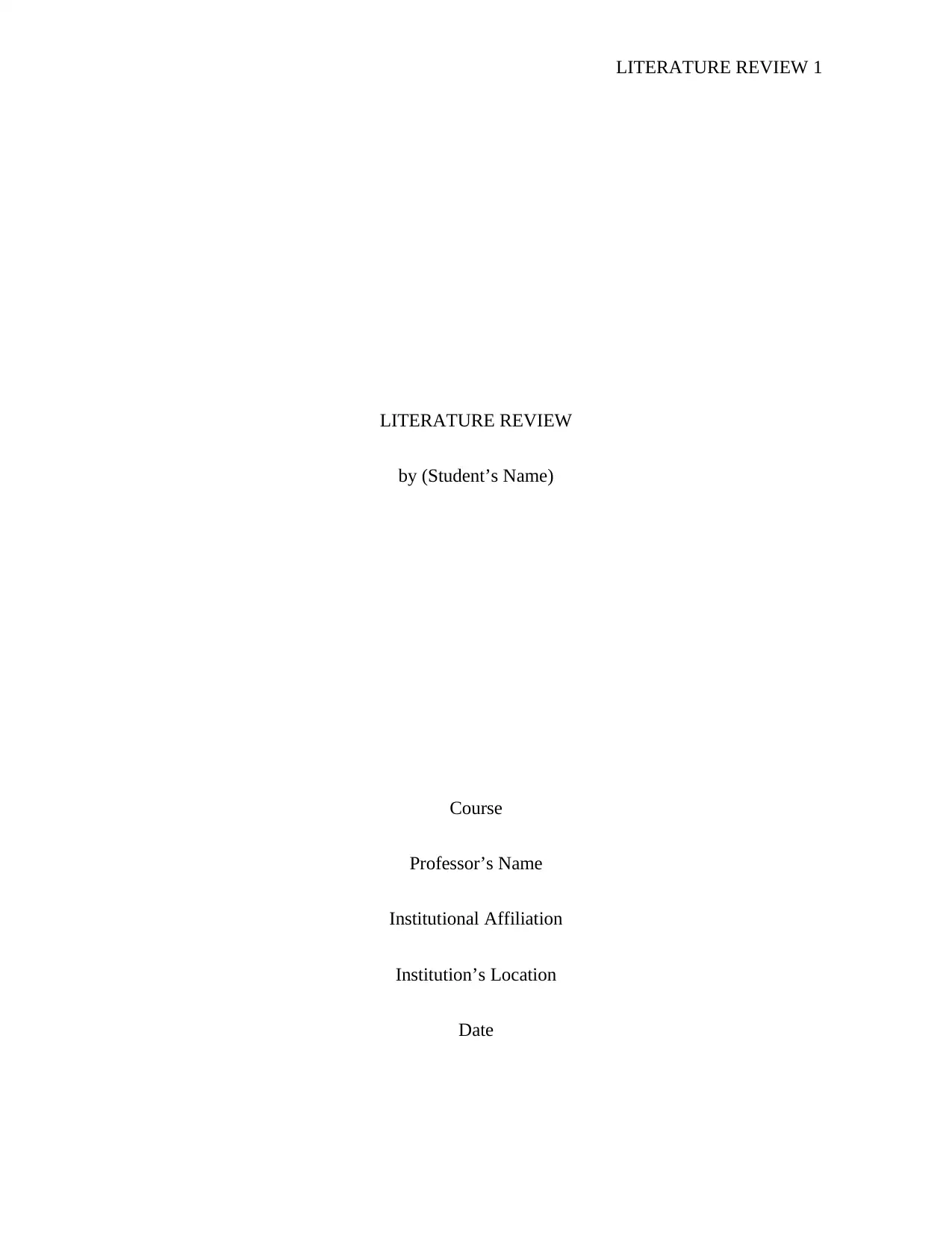
LITERATURE REVIEW 1
LITERATURE REVIEW
by (Student’s Name)
Course
Professor’s Name
Institutional Affiliation
Institution’s Location
Date
LITERATURE REVIEW
by (Student’s Name)
Course
Professor’s Name
Institutional Affiliation
Institution’s Location
Date
Paraphrase This Document
Need a fresh take? Get an instant paraphrase of this document with our AI Paraphraser
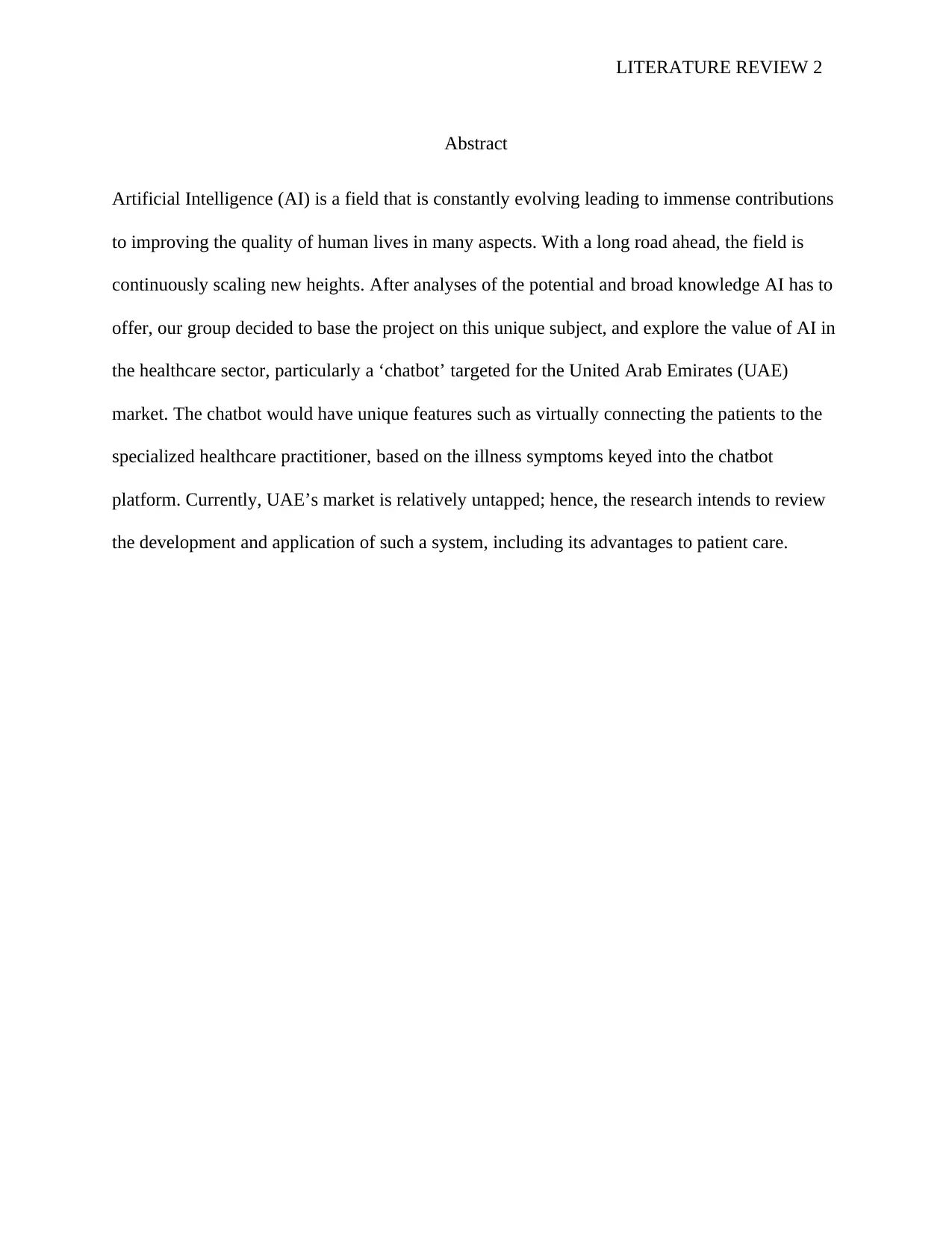
LITERATURE REVIEW 2
Abstract
Artificial Intelligence (AI) is a field that is constantly evolving leading to immense contributions
to improving the quality of human lives in many aspects. With a long road ahead, the field is
continuously scaling new heights. After analyses of the potential and broad knowledge AI has to
offer, our group decided to base the project on this unique subject, and explore the value of AI in
the healthcare sector, particularly a ‘chatbot’ targeted for the United Arab Emirates (UAE)
market. The chatbot would have unique features such as virtually connecting the patients to the
specialized healthcare practitioner, based on the illness symptoms keyed into the chatbot
platform. Currently, UAE’s market is relatively untapped; hence, the research intends to review
the development and application of such a system, including its advantages to patient care.
Abstract
Artificial Intelligence (AI) is a field that is constantly evolving leading to immense contributions
to improving the quality of human lives in many aspects. With a long road ahead, the field is
continuously scaling new heights. After analyses of the potential and broad knowledge AI has to
offer, our group decided to base the project on this unique subject, and explore the value of AI in
the healthcare sector, particularly a ‘chatbot’ targeted for the United Arab Emirates (UAE)
market. The chatbot would have unique features such as virtually connecting the patients to the
specialized healthcare practitioner, based on the illness symptoms keyed into the chatbot
platform. Currently, UAE’s market is relatively untapped; hence, the research intends to review
the development and application of such a system, including its advantages to patient care.
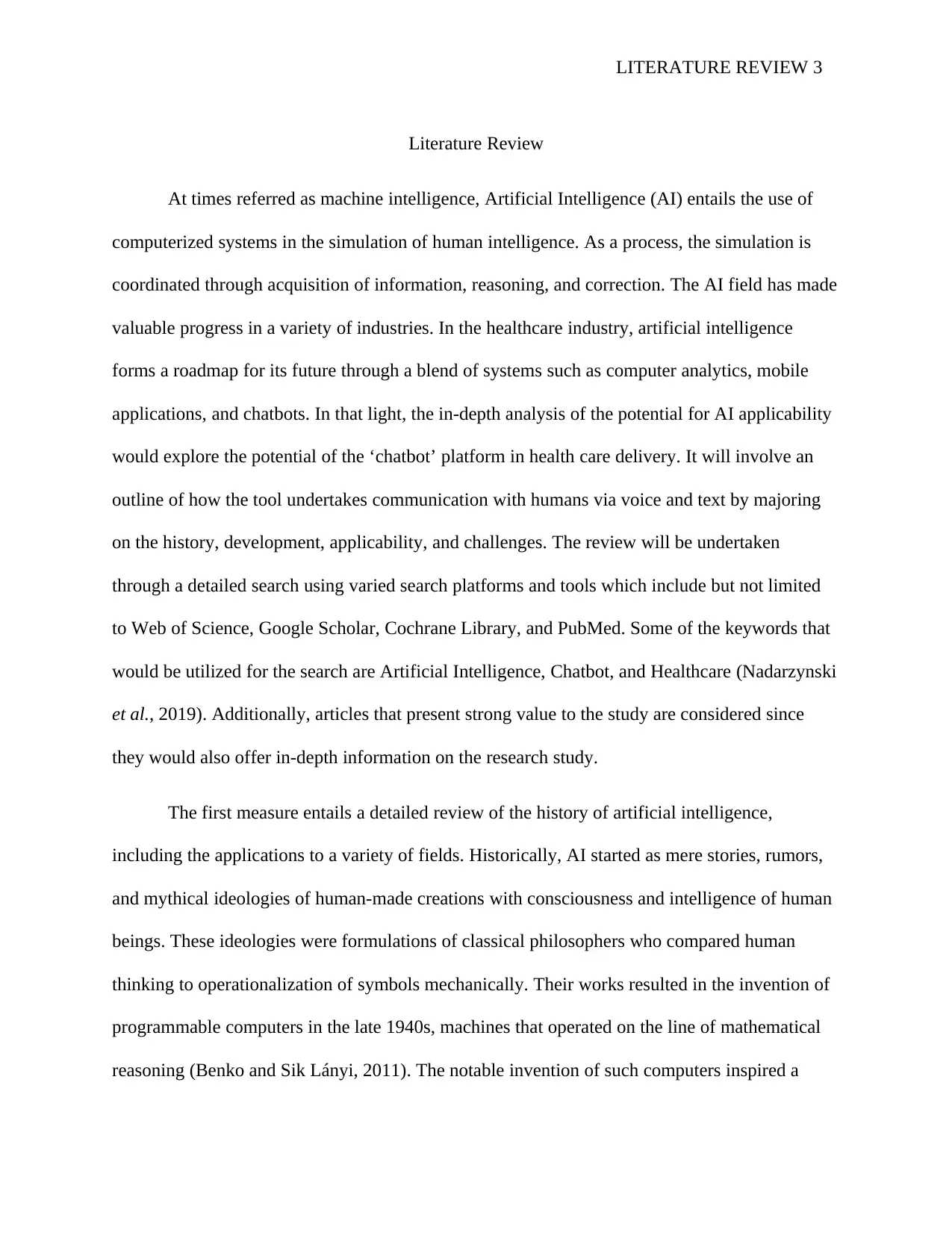
LITERATURE REVIEW 3
Literature Review
At times referred as machine intelligence, Artificial Intelligence (AI) entails the use of
computerized systems in the simulation of human intelligence. As a process, the simulation is
coordinated through acquisition of information, reasoning, and correction. The AI field has made
valuable progress in a variety of industries. In the healthcare industry, artificial intelligence
forms a roadmap for its future through a blend of systems such as computer analytics, mobile
applications, and chatbots. In that light, the in-depth analysis of the potential for AI applicability
would explore the potential of the ‘chatbot’ platform in health care delivery. It will involve an
outline of how the tool undertakes communication with humans via voice and text by majoring
on the history, development, applicability, and challenges. The review will be undertaken
through a detailed search using varied search platforms and tools which include but not limited
to Web of Science, Google Scholar, Cochrane Library, and PubMed. Some of the keywords that
would be utilized for the search are Artificial Intelligence, Chatbot, and Healthcare (Nadarzynski
et al., 2019). Additionally, articles that present strong value to the study are considered since
they would also offer in-depth information on the research study.
The first measure entails a detailed review of the history of artificial intelligence,
including the applications to a variety of fields. Historically, AI started as mere stories, rumors,
and mythical ideologies of human-made creations with consciousness and intelligence of human
beings. These ideologies were formulations of classical philosophers who compared human
thinking to operationalization of symbols mechanically. Their works resulted in the invention of
programmable computers in the late 1940s, machines that operated on the line of mathematical
reasoning (Benko and Sik Lányi, 2011). The notable invention of such computers inspired a
Literature Review
At times referred as machine intelligence, Artificial Intelligence (AI) entails the use of
computerized systems in the simulation of human intelligence. As a process, the simulation is
coordinated through acquisition of information, reasoning, and correction. The AI field has made
valuable progress in a variety of industries. In the healthcare industry, artificial intelligence
forms a roadmap for its future through a blend of systems such as computer analytics, mobile
applications, and chatbots. In that light, the in-depth analysis of the potential for AI applicability
would explore the potential of the ‘chatbot’ platform in health care delivery. It will involve an
outline of how the tool undertakes communication with humans via voice and text by majoring
on the history, development, applicability, and challenges. The review will be undertaken
through a detailed search using varied search platforms and tools which include but not limited
to Web of Science, Google Scholar, Cochrane Library, and PubMed. Some of the keywords that
would be utilized for the search are Artificial Intelligence, Chatbot, and Healthcare (Nadarzynski
et al., 2019). Additionally, articles that present strong value to the study are considered since
they would also offer in-depth information on the research study.
The first measure entails a detailed review of the history of artificial intelligence,
including the applications to a variety of fields. Historically, AI started as mere stories, rumors,
and mythical ideologies of human-made creations with consciousness and intelligence of human
beings. These ideologies were formulations of classical philosophers who compared human
thinking to operationalization of symbols mechanically. Their works resulted in the invention of
programmable computers in the late 1940s, machines that operated on the line of mathematical
reasoning (Benko and Sik Lányi, 2011). The notable invention of such computers inspired a
⊘ This is a preview!⊘
Do you want full access?
Subscribe today to unlock all pages.

Trusted by 1+ million students worldwide
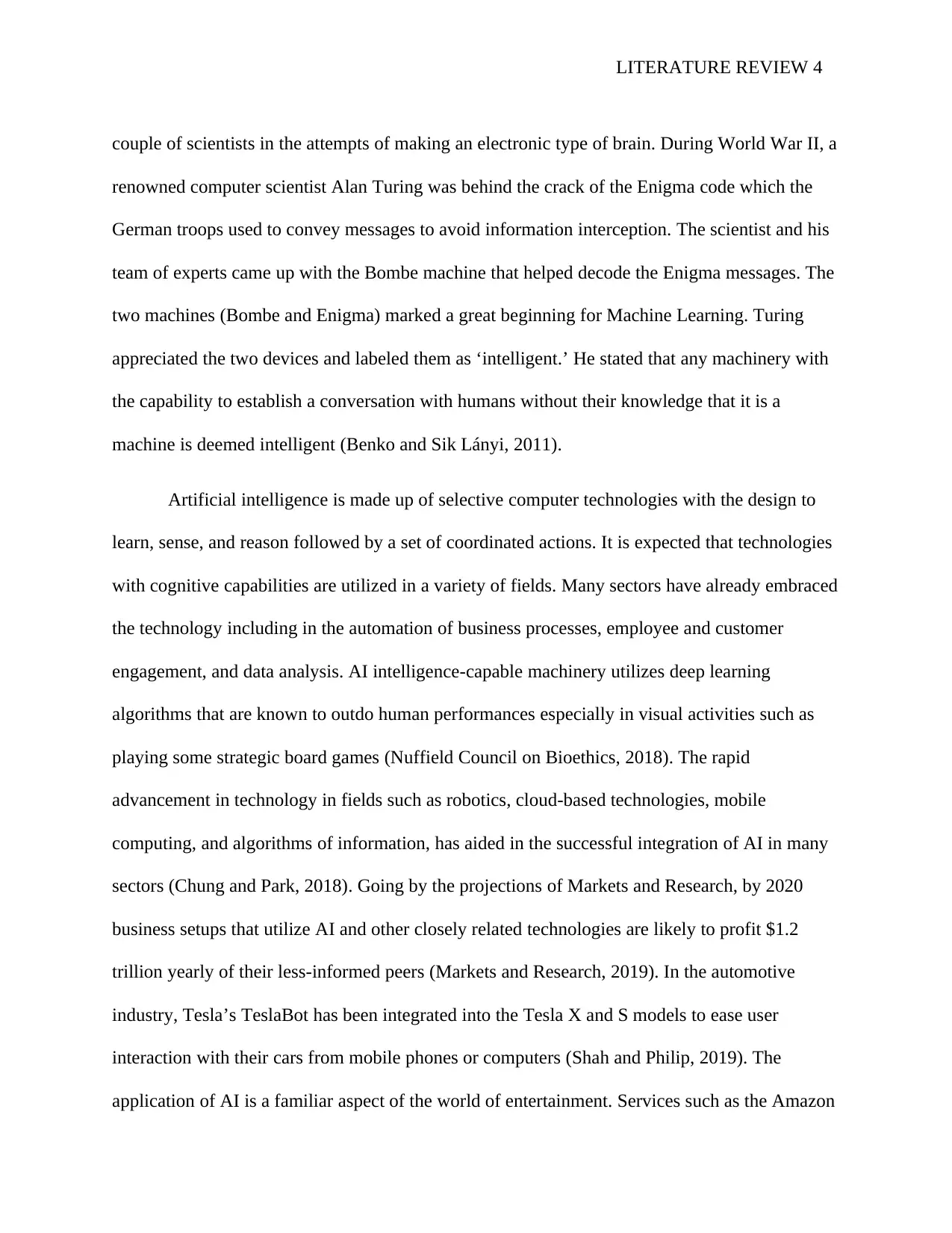
LITERATURE REVIEW 4
couple of scientists in the attempts of making an electronic type of brain. During World War II, a
renowned computer scientist Alan Turing was behind the crack of the Enigma code which the
German troops used to convey messages to avoid information interception. The scientist and his
team of experts came up with the Bombe machine that helped decode the Enigma messages. The
two machines (Bombe and Enigma) marked a great beginning for Machine Learning. Turing
appreciated the two devices and labeled them as ‘intelligent.’ He stated that any machinery with
the capability to establish a conversation with humans without their knowledge that it is a
machine is deemed intelligent (Benko and Sik Lányi, 2011).
Artificial intelligence is made up of selective computer technologies with the design to
learn, sense, and reason followed by a set of coordinated actions. It is expected that technologies
with cognitive capabilities are utilized in a variety of fields. Many sectors have already embraced
the technology including in the automation of business processes, employee and customer
engagement, and data analysis. AI intelligence-capable machinery utilizes deep learning
algorithms that are known to outdo human performances especially in visual activities such as
playing some strategic board games (Nuffield Council on Bioethics, 2018). The rapid
advancement in technology in fields such as robotics, cloud-based technologies, mobile
computing, and algorithms of information, has aided in the successful integration of AI in many
sectors (Chung and Park, 2018). Going by the projections of Markets and Research, by 2020
business setups that utilize AI and other closely related technologies are likely to profit $1.2
trillion yearly of their less-informed peers (Markets and Research, 2019). In the automotive
industry, Tesla’s TeslaBot has been integrated into the Tesla X and S models to ease user
interaction with their cars from mobile phones or computers (Shah and Philip, 2019). The
application of AI is a familiar aspect of the world of entertainment. Services such as the Amazon
couple of scientists in the attempts of making an electronic type of brain. During World War II, a
renowned computer scientist Alan Turing was behind the crack of the Enigma code which the
German troops used to convey messages to avoid information interception. The scientist and his
team of experts came up with the Bombe machine that helped decode the Enigma messages. The
two machines (Bombe and Enigma) marked a great beginning for Machine Learning. Turing
appreciated the two devices and labeled them as ‘intelligent.’ He stated that any machinery with
the capability to establish a conversation with humans without their knowledge that it is a
machine is deemed intelligent (Benko and Sik Lányi, 2011).
Artificial intelligence is made up of selective computer technologies with the design to
learn, sense, and reason followed by a set of coordinated actions. It is expected that technologies
with cognitive capabilities are utilized in a variety of fields. Many sectors have already embraced
the technology including in the automation of business processes, employee and customer
engagement, and data analysis. AI intelligence-capable machinery utilizes deep learning
algorithms that are known to outdo human performances especially in visual activities such as
playing some strategic board games (Nuffield Council on Bioethics, 2018). The rapid
advancement in technology in fields such as robotics, cloud-based technologies, mobile
computing, and algorithms of information, has aided in the successful integration of AI in many
sectors (Chung and Park, 2018). Going by the projections of Markets and Research, by 2020
business setups that utilize AI and other closely related technologies are likely to profit $1.2
trillion yearly of their less-informed peers (Markets and Research, 2019). In the automotive
industry, Tesla’s TeslaBot has been integrated into the Tesla X and S models to ease user
interaction with their cars from mobile phones or computers (Shah and Philip, 2019). The
application of AI is a familiar aspect of the world of entertainment. Services such as the Amazon
Paraphrase This Document
Need a fresh take? Get an instant paraphrase of this document with our AI Paraphraser
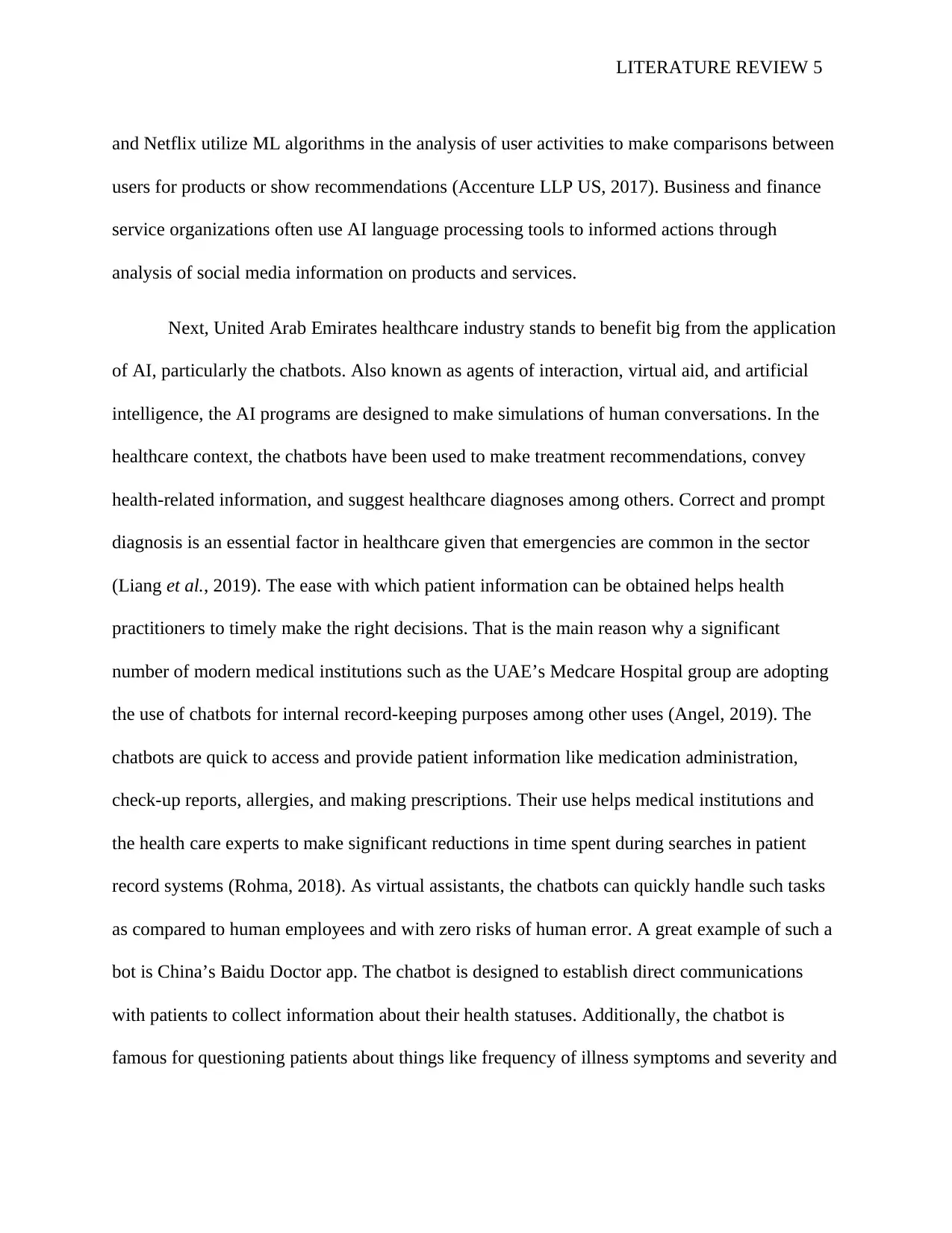
LITERATURE REVIEW 5
and Netflix utilize ML algorithms in the analysis of user activities to make comparisons between
users for products or show recommendations (Accenture LLP US, 2017). Business and finance
service organizations often use AI language processing tools to informed actions through
analysis of social media information on products and services.
Next, United Arab Emirates healthcare industry stands to benefit big from the application
of AI, particularly the chatbots. Also known as agents of interaction, virtual aid, and artificial
intelligence, the AI programs are designed to make simulations of human conversations. In the
healthcare context, the chatbots have been used to make treatment recommendations, convey
health-related information, and suggest healthcare diagnoses among others. Correct and prompt
diagnosis is an essential factor in healthcare given that emergencies are common in the sector
(Liang et al., 2019). The ease with which patient information can be obtained helps health
practitioners to timely make the right decisions. That is the main reason why a significant
number of modern medical institutions such as the UAE’s Medcare Hospital group are adopting
the use of chatbots for internal record-keeping purposes among other uses (Angel, 2019). The
chatbots are quick to access and provide patient information like medication administration,
check-up reports, allergies, and making prescriptions. Their use helps medical institutions and
the health care experts to make significant reductions in time spent during searches in patient
record systems (Rohma, 2018). As virtual assistants, the chatbots can quickly handle such tasks
as compared to human employees and with zero risks of human error. A great example of such a
bot is China’s Baidu Doctor app. The chatbot is designed to establish direct communications
with patients to collect information about their health statuses. Additionally, the chatbot is
famous for questioning patients about things like frequency of illness symptoms and severity and
and Netflix utilize ML algorithms in the analysis of user activities to make comparisons between
users for products or show recommendations (Accenture LLP US, 2017). Business and finance
service organizations often use AI language processing tools to informed actions through
analysis of social media information on products and services.
Next, United Arab Emirates healthcare industry stands to benefit big from the application
of AI, particularly the chatbots. Also known as agents of interaction, virtual aid, and artificial
intelligence, the AI programs are designed to make simulations of human conversations. In the
healthcare context, the chatbots have been used to make treatment recommendations, convey
health-related information, and suggest healthcare diagnoses among others. Correct and prompt
diagnosis is an essential factor in healthcare given that emergencies are common in the sector
(Liang et al., 2019). The ease with which patient information can be obtained helps health
practitioners to timely make the right decisions. That is the main reason why a significant
number of modern medical institutions such as the UAE’s Medcare Hospital group are adopting
the use of chatbots for internal record-keeping purposes among other uses (Angel, 2019). The
chatbots are quick to access and provide patient information like medication administration,
check-up reports, allergies, and making prescriptions. Their use helps medical institutions and
the health care experts to make significant reductions in time spent during searches in patient
record systems (Rohma, 2018). As virtual assistants, the chatbots can quickly handle such tasks
as compared to human employees and with zero risks of human error. A great example of such a
bot is China’s Baidu Doctor app. The chatbot is designed to establish direct communications
with patients to collect information about their health statuses. Additionally, the chatbot is
famous for questioning patients about things like frequency of illness symptoms and severity and
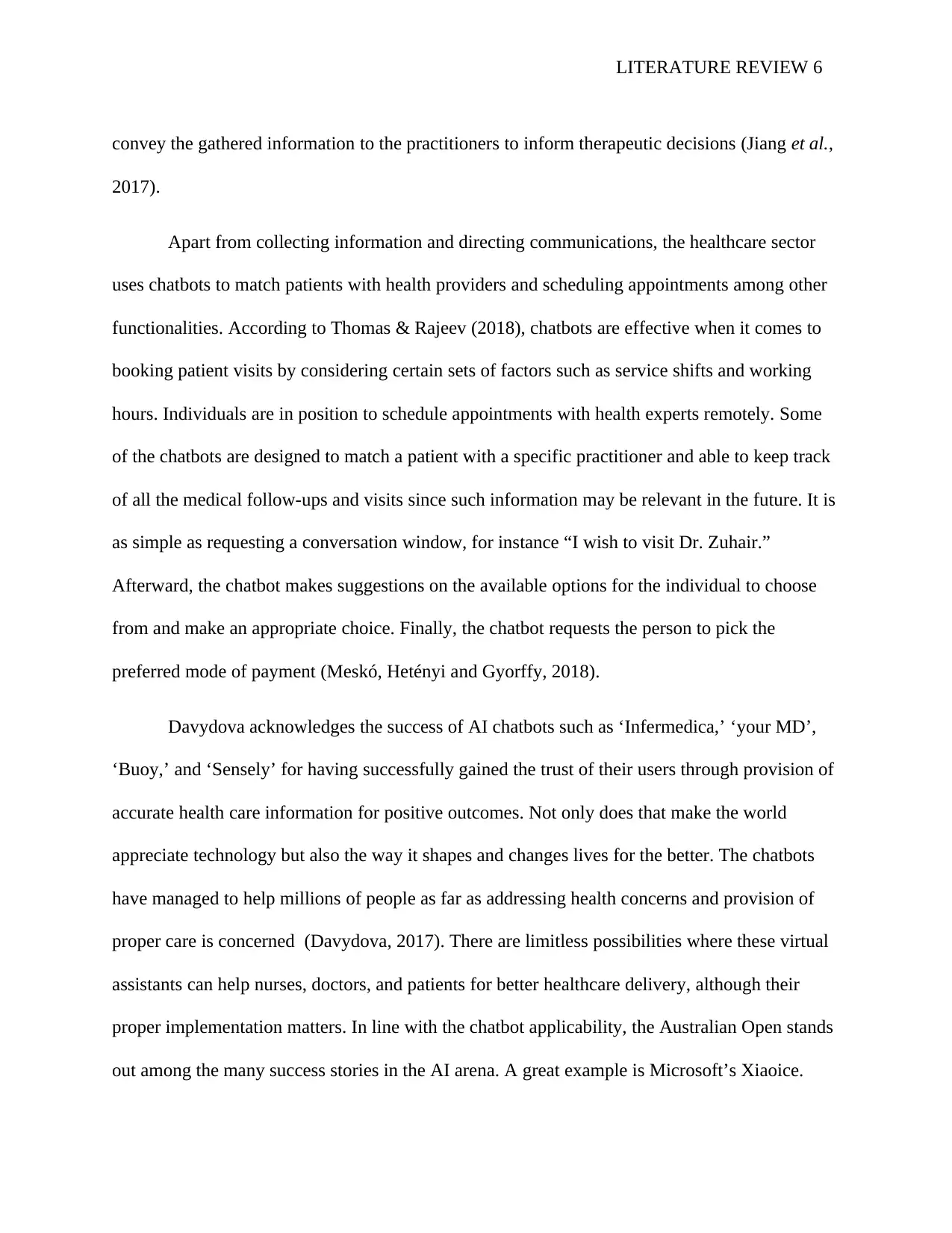
LITERATURE REVIEW 6
convey the gathered information to the practitioners to inform therapeutic decisions (Jiang et al.,
2017).
Apart from collecting information and directing communications, the healthcare sector
uses chatbots to match patients with health providers and scheduling appointments among other
functionalities. According to Thomas & Rajeev (2018), chatbots are effective when it comes to
booking patient visits by considering certain sets of factors such as service shifts and working
hours. Individuals are in position to schedule appointments with health experts remotely. Some
of the chatbots are designed to match a patient with a specific practitioner and able to keep track
of all the medical follow-ups and visits since such information may be relevant in the future. It is
as simple as requesting a conversation window, for instance “I wish to visit Dr. Zuhair.”
Afterward, the chatbot makes suggestions on the available options for the individual to choose
from and make an appropriate choice. Finally, the chatbot requests the person to pick the
preferred mode of payment (Meskó, Hetényi and Gyorffy, 2018).
Davydova acknowledges the success of AI chatbots such as ‘Infermedica,’ ‘your MD’,
‘Buoy,’ and ‘Sensely’ for having successfully gained the trust of their users through provision of
accurate health care information for positive outcomes. Not only does that make the world
appreciate technology but also the way it shapes and changes lives for the better. The chatbots
have managed to help millions of people as far as addressing health concerns and provision of
proper care is concerned (Davydova, 2017). There are limitless possibilities where these virtual
assistants can help nurses, doctors, and patients for better healthcare delivery, although their
proper implementation matters. In line with the chatbot applicability, the Australian Open stands
out among the many success stories in the AI arena. A great example is Microsoft’s Xiaoice.
convey the gathered information to the practitioners to inform therapeutic decisions (Jiang et al.,
2017).
Apart from collecting information and directing communications, the healthcare sector
uses chatbots to match patients with health providers and scheduling appointments among other
functionalities. According to Thomas & Rajeev (2018), chatbots are effective when it comes to
booking patient visits by considering certain sets of factors such as service shifts and working
hours. Individuals are in position to schedule appointments with health experts remotely. Some
of the chatbots are designed to match a patient with a specific practitioner and able to keep track
of all the medical follow-ups and visits since such information may be relevant in the future. It is
as simple as requesting a conversation window, for instance “I wish to visit Dr. Zuhair.”
Afterward, the chatbot makes suggestions on the available options for the individual to choose
from and make an appropriate choice. Finally, the chatbot requests the person to pick the
preferred mode of payment (Meskó, Hetényi and Gyorffy, 2018).
Davydova acknowledges the success of AI chatbots such as ‘Infermedica,’ ‘your MD’,
‘Buoy,’ and ‘Sensely’ for having successfully gained the trust of their users through provision of
accurate health care information for positive outcomes. Not only does that make the world
appreciate technology but also the way it shapes and changes lives for the better. The chatbots
have managed to help millions of people as far as addressing health concerns and provision of
proper care is concerned (Davydova, 2017). There are limitless possibilities where these virtual
assistants can help nurses, doctors, and patients for better healthcare delivery, although their
proper implementation matters. In line with the chatbot applicability, the Australian Open stands
out among the many success stories in the AI arena. A great example is Microsoft’s Xiaoice.
⊘ This is a preview!⊘
Do you want full access?
Subscribe today to unlock all pages.

Trusted by 1+ million students worldwide
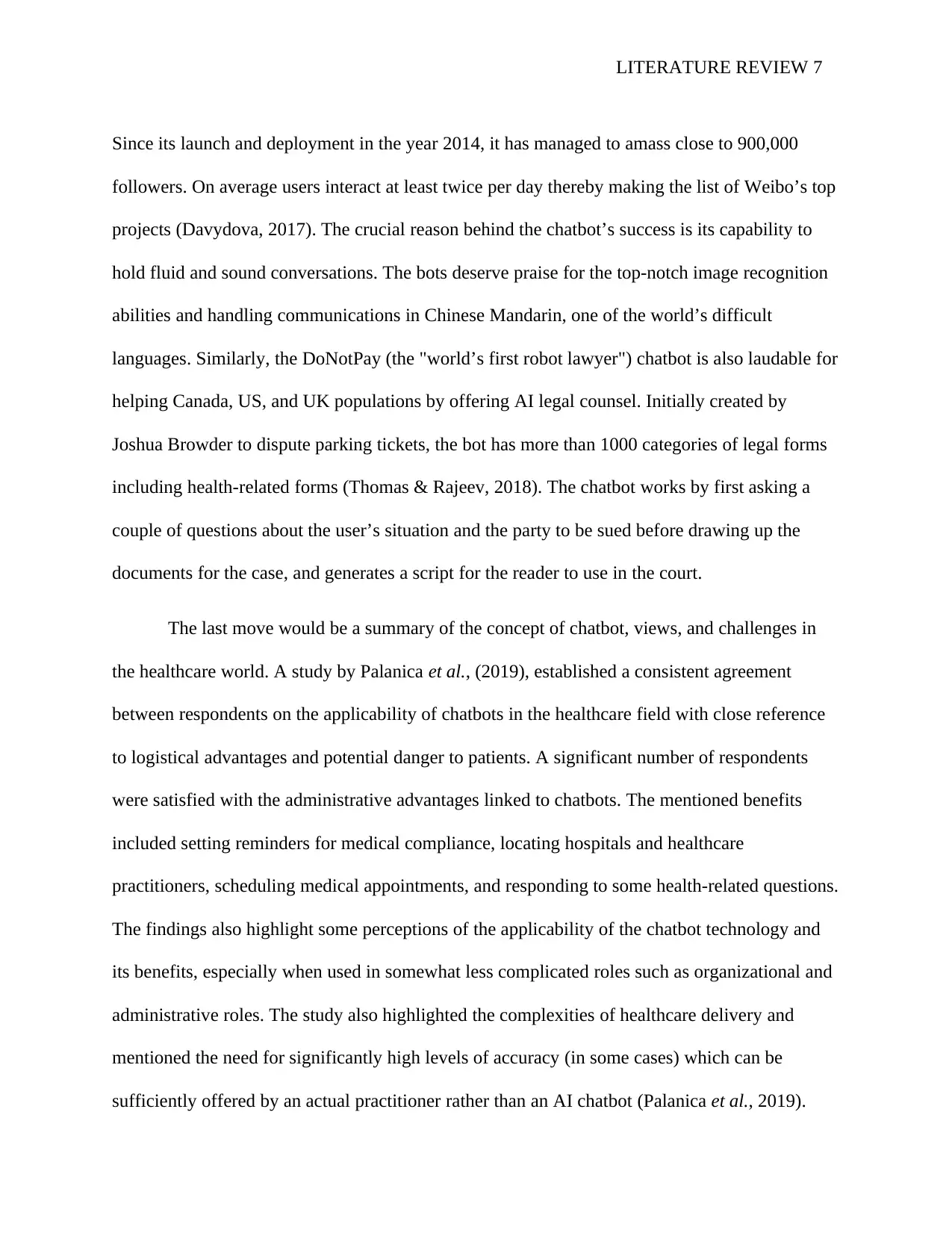
LITERATURE REVIEW 7
Since its launch and deployment in the year 2014, it has managed to amass close to 900,000
followers. On average users interact at least twice per day thereby making the list of Weibo’s top
projects (Davydova, 2017). The crucial reason behind the chatbot’s success is its capability to
hold fluid and sound conversations. The bots deserve praise for the top-notch image recognition
abilities and handling communications in Chinese Mandarin, one of the world’s difficult
languages. Similarly, the DoNotPay (the "world’s first robot lawyer") chatbot is also laudable for
helping Canada, US, and UK populations by offering AI legal counsel. Initially created by
Joshua Browder to dispute parking tickets, the bot has more than 1000 categories of legal forms
including health-related forms (Thomas & Rajeev, 2018). The chatbot works by first asking a
couple of questions about the user’s situation and the party to be sued before drawing up the
documents for the case, and generates a script for the reader to use in the court.
The last move would be a summary of the concept of chatbot, views, and challenges in
the healthcare world. A study by Palanica et al., (2019), established a consistent agreement
between respondents on the applicability of chatbots in the healthcare field with close reference
to logistical advantages and potential danger to patients. A significant number of respondents
were satisfied with the administrative advantages linked to chatbots. The mentioned benefits
included setting reminders for medical compliance, locating hospitals and healthcare
practitioners, scheduling medical appointments, and responding to some health-related questions.
The findings also highlight some perceptions of the applicability of the chatbot technology and
its benefits, especially when used in somewhat less complicated roles such as organizational and
administrative roles. The study also highlighted the complexities of healthcare delivery and
mentioned the need for significantly high levels of accuracy (in some cases) which can be
sufficiently offered by an actual practitioner rather than an AI chatbot (Palanica et al., 2019).
Since its launch and deployment in the year 2014, it has managed to amass close to 900,000
followers. On average users interact at least twice per day thereby making the list of Weibo’s top
projects (Davydova, 2017). The crucial reason behind the chatbot’s success is its capability to
hold fluid and sound conversations. The bots deserve praise for the top-notch image recognition
abilities and handling communications in Chinese Mandarin, one of the world’s difficult
languages. Similarly, the DoNotPay (the "world’s first robot lawyer") chatbot is also laudable for
helping Canada, US, and UK populations by offering AI legal counsel. Initially created by
Joshua Browder to dispute parking tickets, the bot has more than 1000 categories of legal forms
including health-related forms (Thomas & Rajeev, 2018). The chatbot works by first asking a
couple of questions about the user’s situation and the party to be sued before drawing up the
documents for the case, and generates a script for the reader to use in the court.
The last move would be a summary of the concept of chatbot, views, and challenges in
the healthcare world. A study by Palanica et al., (2019), established a consistent agreement
between respondents on the applicability of chatbots in the healthcare field with close reference
to logistical advantages and potential danger to patients. A significant number of respondents
were satisfied with the administrative advantages linked to chatbots. The mentioned benefits
included setting reminders for medical compliance, locating hospitals and healthcare
practitioners, scheduling medical appointments, and responding to some health-related questions.
The findings also highlight some perceptions of the applicability of the chatbot technology and
its benefits, especially when used in somewhat less complicated roles such as organizational and
administrative roles. The study also highlighted the complexities of healthcare delivery and
mentioned the need for significantly high levels of accuracy (in some cases) which can be
sufficiently offered by an actual practitioner rather than an AI chatbot (Palanica et al., 2019).
Paraphrase This Document
Need a fresh take? Get an instant paraphrase of this document with our AI Paraphraser
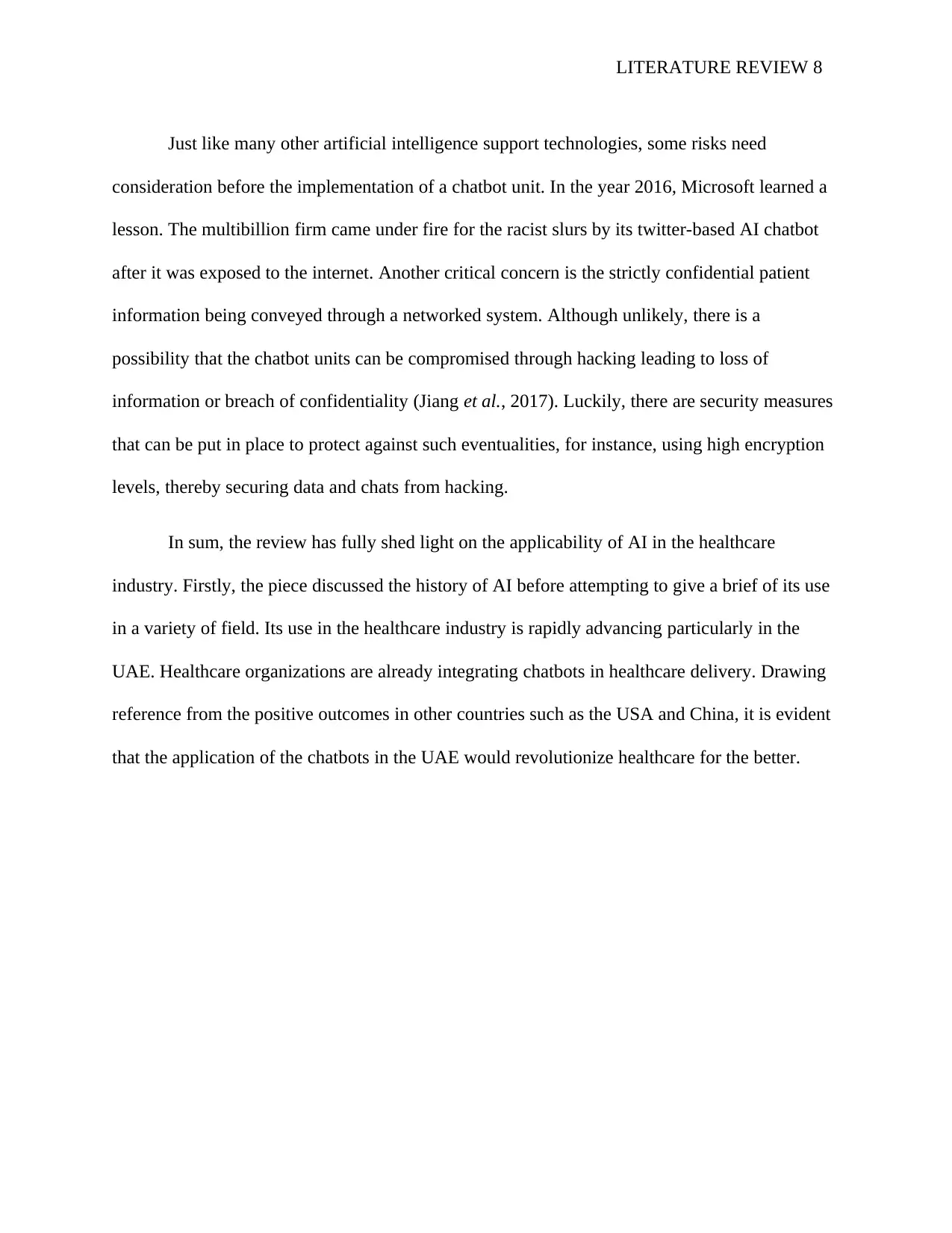
LITERATURE REVIEW 8
Just like many other artificial intelligence support technologies, some risks need
consideration before the implementation of a chatbot unit. In the year 2016, Microsoft learned a
lesson. The multibillion firm came under fire for the racist slurs by its twitter-based AI chatbot
after it was exposed to the internet. Another critical concern is the strictly confidential patient
information being conveyed through a networked system. Although unlikely, there is a
possibility that the chatbot units can be compromised through hacking leading to loss of
information or breach of confidentiality (Jiang et al., 2017). Luckily, there are security measures
that can be put in place to protect against such eventualities, for instance, using high encryption
levels, thereby securing data and chats from hacking.
In sum, the review has fully shed light on the applicability of AI in the healthcare
industry. Firstly, the piece discussed the history of AI before attempting to give a brief of its use
in a variety of field. Its use in the healthcare industry is rapidly advancing particularly in the
UAE. Healthcare organizations are already integrating chatbots in healthcare delivery. Drawing
reference from the positive outcomes in other countries such as the USA and China, it is evident
that the application of the chatbots in the UAE would revolutionize healthcare for the better.
Just like many other artificial intelligence support technologies, some risks need
consideration before the implementation of a chatbot unit. In the year 2016, Microsoft learned a
lesson. The multibillion firm came under fire for the racist slurs by its twitter-based AI chatbot
after it was exposed to the internet. Another critical concern is the strictly confidential patient
information being conveyed through a networked system. Although unlikely, there is a
possibility that the chatbot units can be compromised through hacking leading to loss of
information or breach of confidentiality (Jiang et al., 2017). Luckily, there are security measures
that can be put in place to protect against such eventualities, for instance, using high encryption
levels, thereby securing data and chats from hacking.
In sum, the review has fully shed light on the applicability of AI in the healthcare
industry. Firstly, the piece discussed the history of AI before attempting to give a brief of its use
in a variety of field. Its use in the healthcare industry is rapidly advancing particularly in the
UAE. Healthcare organizations are already integrating chatbots in healthcare delivery. Drawing
reference from the positive outcomes in other countries such as the USA and China, it is evident
that the application of the chatbots in the UAE would revolutionize healthcare for the better.
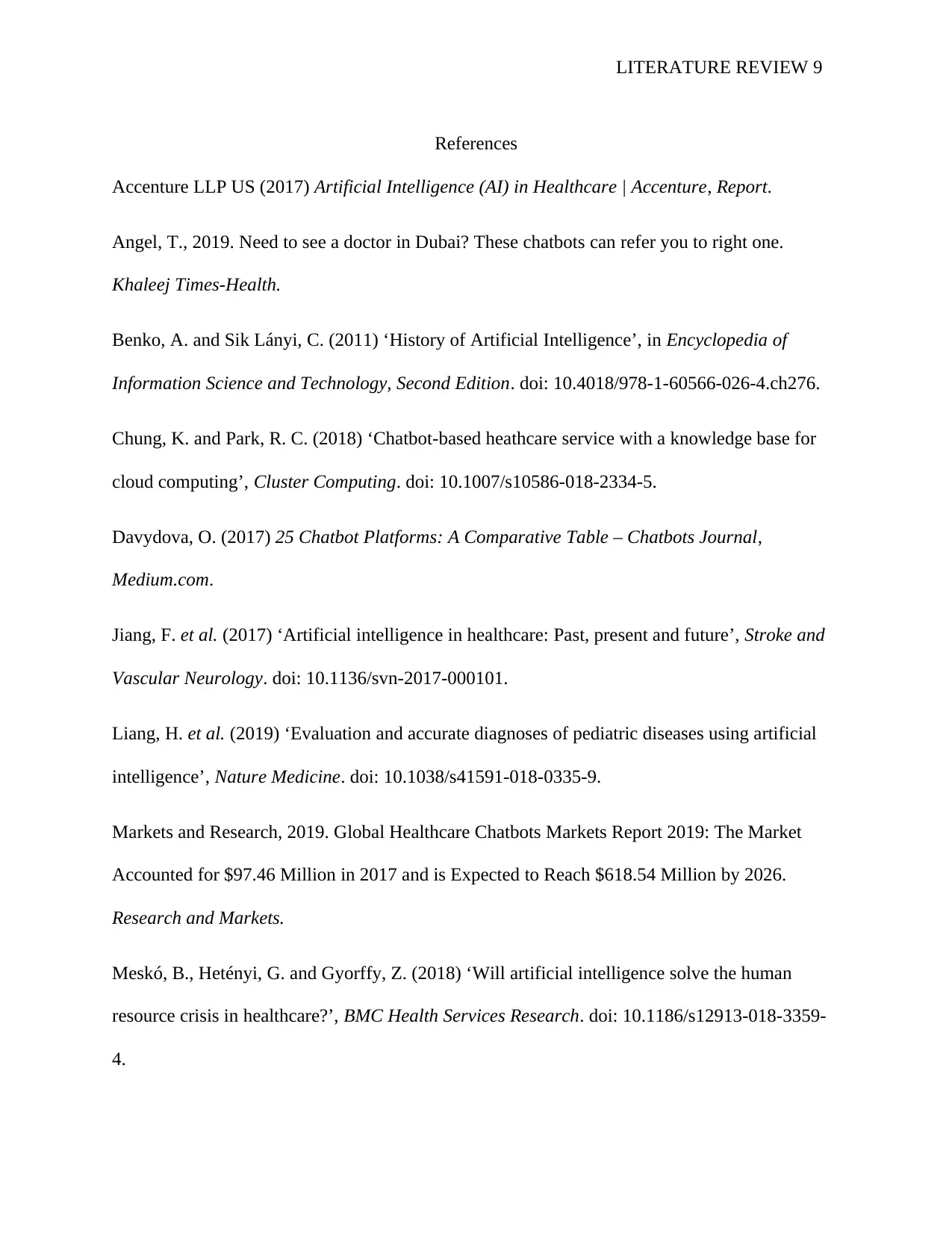
LITERATURE REVIEW 9
References
Accenture LLP US (2017) Artificial Intelligence (AI) in Healthcare | Accenture, Report.
Angel, T., 2019. Need to see a doctor in Dubai? These chatbots can refer you to right one.
Khaleej Times-Health.
Benko, A. and Sik Lányi, C. (2011) ‘History of Artificial Intelligence’, in Encyclopedia of
Information Science and Technology, Second Edition. doi: 10.4018/978-1-60566-026-4.ch276.
Chung, K. and Park, R. C. (2018) ‘Chatbot-based heathcare service with a knowledge base for
cloud computing’, Cluster Computing. doi: 10.1007/s10586-018-2334-5.
Davydova, O. (2017) 25 Chatbot Platforms: A Comparative Table – Chatbots Journal,
Medium.com.
Jiang, F. et al. (2017) ‘Artificial intelligence in healthcare: Past, present and future’, Stroke and
Vascular Neurology. doi: 10.1136/svn-2017-000101.
Liang, H. et al. (2019) ‘Evaluation and accurate diagnoses of pediatric diseases using artificial
intelligence’, Nature Medicine. doi: 10.1038/s41591-018-0335-9.
Markets and Research, 2019. Global Healthcare Chatbots Markets Report 2019: The Market
Accounted for $97.46 Million in 2017 and is Expected to Reach $618.54 Million by 2026.
Research and Markets.
Meskó, B., Hetényi, G. and Gyorffy, Z. (2018) ‘Will artificial intelligence solve the human
resource crisis in healthcare?’, BMC Health Services Research. doi: 10.1186/s12913-018-3359-
4.
References
Accenture LLP US (2017) Artificial Intelligence (AI) in Healthcare | Accenture, Report.
Angel, T., 2019. Need to see a doctor in Dubai? These chatbots can refer you to right one.
Khaleej Times-Health.
Benko, A. and Sik Lányi, C. (2011) ‘History of Artificial Intelligence’, in Encyclopedia of
Information Science and Technology, Second Edition. doi: 10.4018/978-1-60566-026-4.ch276.
Chung, K. and Park, R. C. (2018) ‘Chatbot-based heathcare service with a knowledge base for
cloud computing’, Cluster Computing. doi: 10.1007/s10586-018-2334-5.
Davydova, O. (2017) 25 Chatbot Platforms: A Comparative Table – Chatbots Journal,
Medium.com.
Jiang, F. et al. (2017) ‘Artificial intelligence in healthcare: Past, present and future’, Stroke and
Vascular Neurology. doi: 10.1136/svn-2017-000101.
Liang, H. et al. (2019) ‘Evaluation and accurate diagnoses of pediatric diseases using artificial
intelligence’, Nature Medicine. doi: 10.1038/s41591-018-0335-9.
Markets and Research, 2019. Global Healthcare Chatbots Markets Report 2019: The Market
Accounted for $97.46 Million in 2017 and is Expected to Reach $618.54 Million by 2026.
Research and Markets.
Meskó, B., Hetényi, G. and Gyorffy, Z. (2018) ‘Will artificial intelligence solve the human
resource crisis in healthcare?’, BMC Health Services Research. doi: 10.1186/s12913-018-3359-
4.
⊘ This is a preview!⊘
Do you want full access?
Subscribe today to unlock all pages.

Trusted by 1+ million students worldwide
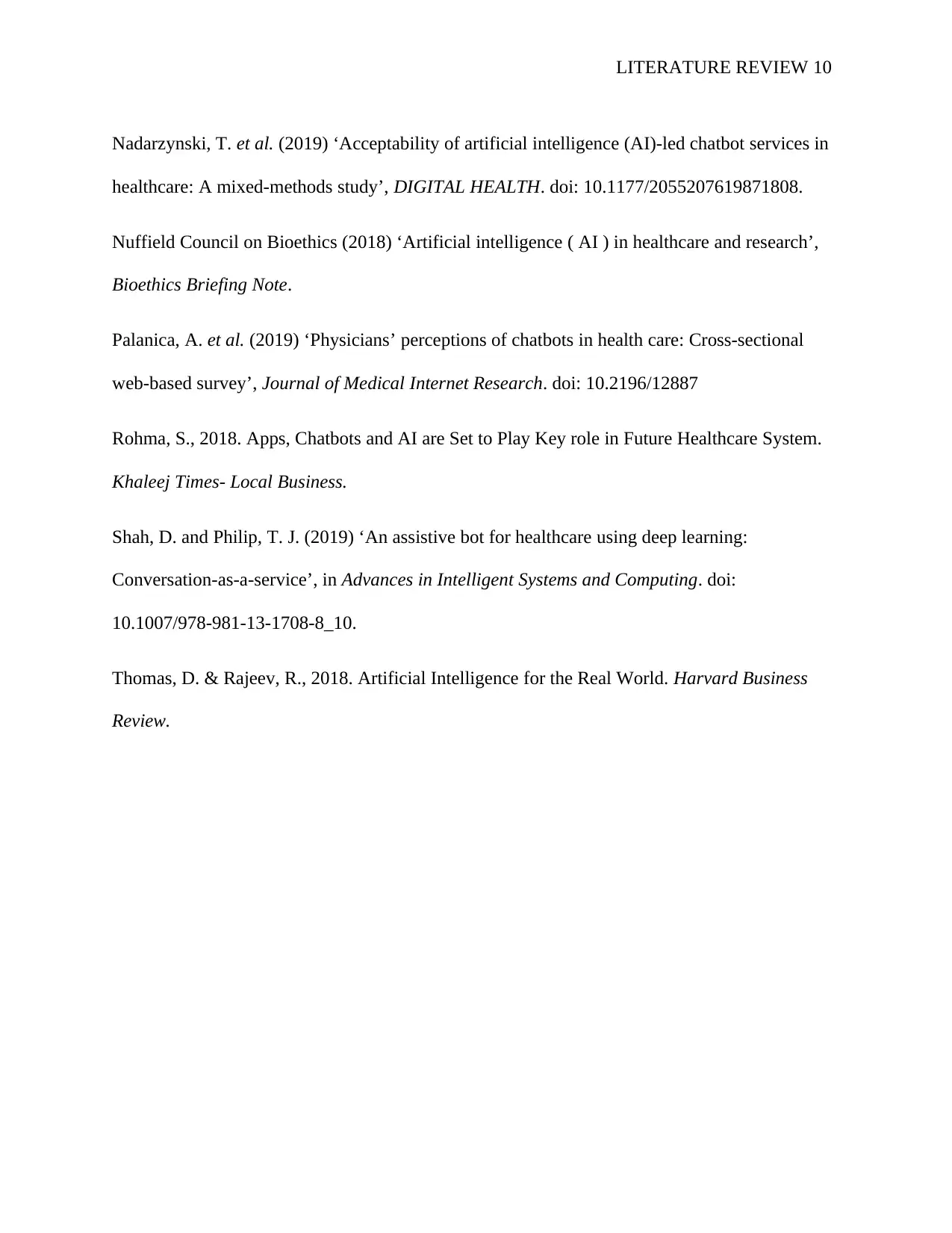
LITERATURE REVIEW 10
Nadarzynski, T. et al. (2019) ‘Acceptability of artificial intelligence (AI)-led chatbot services in
healthcare: A mixed-methods study’, DIGITAL HEALTH. doi: 10.1177/2055207619871808.
Nuffield Council on Bioethics (2018) ‘Artificial intelligence ( AI ) in healthcare and research’,
Bioethics Briefing Note.
Palanica, A. et al. (2019) ‘Physicians’ perceptions of chatbots in health care: Cross-sectional
web-based survey’, Journal of Medical Internet Research. doi: 10.2196/12887
Rohma, S., 2018. Apps, Chatbots and AI are Set to Play Key role in Future Healthcare System.
Khaleej Times- Local Business.
Shah, D. and Philip, T. J. (2019) ‘An assistive bot for healthcare using deep learning:
Conversation-as-a-service’, in Advances in Intelligent Systems and Computing. doi:
10.1007/978-981-13-1708-8_10.
Thomas, D. & Rajeev, R., 2018. Artificial Intelligence for the Real World. Harvard Business
Review.
Nadarzynski, T. et al. (2019) ‘Acceptability of artificial intelligence (AI)-led chatbot services in
healthcare: A mixed-methods study’, DIGITAL HEALTH. doi: 10.1177/2055207619871808.
Nuffield Council on Bioethics (2018) ‘Artificial intelligence ( AI ) in healthcare and research’,
Bioethics Briefing Note.
Palanica, A. et al. (2019) ‘Physicians’ perceptions of chatbots in health care: Cross-sectional
web-based survey’, Journal of Medical Internet Research. doi: 10.2196/12887
Rohma, S., 2018. Apps, Chatbots and AI are Set to Play Key role in Future Healthcare System.
Khaleej Times- Local Business.
Shah, D. and Philip, T. J. (2019) ‘An assistive bot for healthcare using deep learning:
Conversation-as-a-service’, in Advances in Intelligent Systems and Computing. doi:
10.1007/978-981-13-1708-8_10.
Thomas, D. & Rajeev, R., 2018. Artificial Intelligence for the Real World. Harvard Business
Review.
1 out of 10
Related Documents
Your All-in-One AI-Powered Toolkit for Academic Success.
+13062052269
info@desklib.com
Available 24*7 on WhatsApp / Email
![[object Object]](/_next/static/media/star-bottom.7253800d.svg)
Unlock your academic potential
Copyright © 2020–2025 A2Z Services. All Rights Reserved. Developed and managed by ZUCOL.





